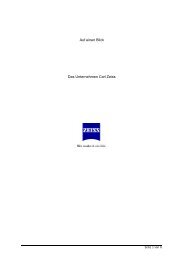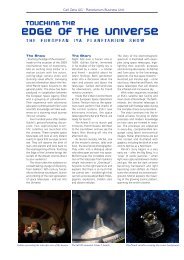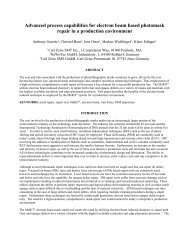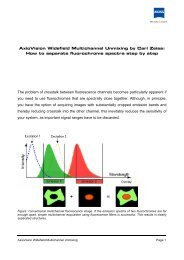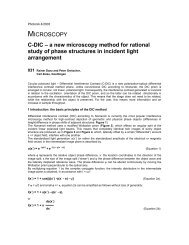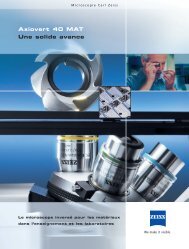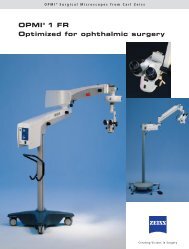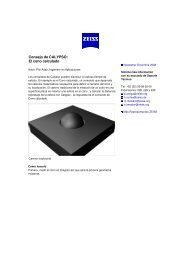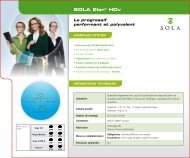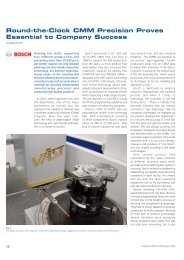An Introduction to the Helium Ion Microscope - Carl Zeiss SMT
An Introduction to the Helium Ion Microscope - Carl Zeiss SMT
An Introduction to the Helium Ion Microscope - Carl Zeiss SMT
Create successful ePaper yourself
Turn your PDF publications into a flip-book with our unique Google optimized e-Paper software.
<strong>An</strong> <strong>Introduction</strong> <strong>to</strong> <strong>the</strong> <strong>Helium</strong> <strong>Ion</strong><br />
<strong>Microscope</strong><br />
John Morgan, John Notte, Raymond Hill, Bill Ward<br />
ALIS Corporation, Peabody, MA<br />
jmorgan@aliscorporation.com<br />
<strong>Introduction</strong><br />
In order <strong>to</strong> get high resolution images from any scanning<br />
beam microscope one must be able <strong>to</strong> produce a sufficiently<br />
small probe, have a small interaction volume in <strong>the</strong> substrate<br />
and have an abundance of information-rich particles <strong>to</strong> collect <strong>to</strong><br />
create <strong>the</strong> image. A typical scanning electron microscope is able<br />
<strong>to</strong> meet all of <strong>the</strong>se requirements <strong>to</strong> some degree. However, a helium<br />
ion microscope based on a Gas Field <strong>Ion</strong> Source (GFIS) has<br />
significant advantages over <strong>the</strong> SEM in all three categories.<br />
The ultimate probe size in a SEM is limited by diffraction<br />
and chromatic aberration. Due <strong>to</strong> <strong>the</strong> very high source brightness<br />
and <strong>the</strong> shorter wavelength of <strong>the</strong> helium ions, it is possible <strong>to</strong><br />
focus <strong>the</strong> ion beam <strong>to</strong> a smaller probe size relative <strong>to</strong> <strong>the</strong> SEM.<br />
<strong>An</strong> electron beam has a relatively large excitation volume<br />
in <strong>the</strong> substrate. This limits <strong>the</strong> resolution of an SEM regardless<br />
of <strong>the</strong> probe size. A helium ion beam does not suffer from this<br />
effect as <strong>the</strong> excitation volume is much smaller than that of <strong>the</strong><br />
SEM.<br />
SEM’s are typically<br />
run at or near<br />
<strong>the</strong>ir secondary electron<br />
unity crossover<br />
point <strong>to</strong> minimize<br />
charging of <strong>the</strong> sample.<br />
This implies that<br />
for each incoming<br />
electron, one secondary<br />
electron is made<br />
available for imaging.<br />
The situation with <strong>the</strong><br />
helium ion beam is<br />
much more favorable.<br />
Typically for each in-<br />
Figure 1: The geometry of a simple Field<br />
<strong>Ion</strong> <strong>Microscope</strong> (FIM).<br />
coming helium ion<br />
from 2 <strong>to</strong> 8 secondary<br />
electrons are generated.<br />
This abundance of<br />
secondary electrons<br />
allows for very high contrast imaging.<br />
In addition <strong>to</strong> secondary electrons, backscattered helium<br />
ions are also available for imaging. These ions are not as abundant<br />
as secondary electrons, but do provide unique contrast<br />
mechanisms that allow quantitative discrimination between<br />
materials with sub-micron spatial resolution.<br />
The <strong>Ion</strong> Source<br />
In recent decades <strong>the</strong>re have been many efforts <strong>to</strong> develop<br />
a high brightness source of noble gas a<strong>to</strong>ms with a low energy<br />
spread. A recent summary of <strong>the</strong>se efforts, and <strong>the</strong>ir limitations,<br />
can be found in <strong>the</strong> literature [1]. The properties of high bright-<br />
24 n MICROSCOPY TODAY July 2006<br />
Reprinted from MICROSCOPY TODAY, Volume 14, Number 4, July 2006.<br />
ness and low energy spread are desired so that <strong>the</strong> beam of ions<br />
can be focused <strong>to</strong> <strong>the</strong> smallest possible probe size on <strong>the</strong> sample.<br />
A beam consisting of noble gas ions is preferred <strong>to</strong> minimize<br />
any chemical, electrical, or optical alteration of <strong>the</strong> sample. If<br />
helium is used as <strong>the</strong> noble gas, <strong>the</strong>re is <strong>the</strong> additional benefit<br />
of minimal sputtering of <strong>the</strong> substrate.<br />
ALIS Corporation has developed a high brightness, monochromatic<br />
source of noble gas ions, which is well-suited <strong>to</strong><br />
high resolution microscopy. The ion source developed at ALIS<br />
Corporation is best unders<strong>to</strong>od by comparison with a related<br />
technology, <strong>the</strong> Field <strong>Ion</strong> <strong>Microscope</strong> (FIM).<br />
Figure 2: Neutral helium a<strong>to</strong>ms (yellow) are drawn <strong>to</strong>wards <strong>the</strong> tip by<br />
a polarization effect. When <strong>the</strong>y pass through <strong>the</strong> ionization disk (blue)<br />
<strong>the</strong>y are ionized (orange) and are accelerated away from <strong>the</strong> tip.<br />
A Closely Related Technology: The Field <strong>Ion</strong> <strong>Microscope</strong><br />
The field ion microscope was optimized in 1955 by E.<br />
Müller, and K. Bahadur. The concept relies upon a cryogenically<br />
cooled, sharp tip in a UHV vacuum system, <strong>to</strong> which small<br />
amounts of helium gas have been admitted. In its simplest form,<br />
<strong>the</strong> geometry is shown in figure 1.<br />
The sharp tip was originally made of tungsten, and <strong>the</strong><br />
sharp tip is commonly achieved by standard electro-chemical<br />
etching procedures. When <strong>the</strong> tip is positively biased in<br />
<strong>the</strong> presence of an adjacent grounded electrode, a very large<br />
electric field is formed at<br />
<strong>the</strong> tip. The maximum<br />
field is, of course, at <strong>the</strong><br />
sharpest corners, and with<br />
only modest voltages (5kV<br />
<strong>to</strong> 30kV) field strengths<br />
of 5 V/Å can be achieved.<br />
At this field strength, <strong>the</strong><br />
tungsten a<strong>to</strong>ms from <strong>the</strong><br />
most protruding points will<br />
be field evaporated from <strong>the</strong><br />
bulk. By this process, <strong>the</strong><br />
end shape is significantly<br />
smoo<strong>the</strong>d until <strong>the</strong> sharpest<br />
corners reside at steps of <strong>the</strong><br />
Figure 3: A typical FIM image<br />
shows many helium beams. Each<br />
beam emanates from an ionization<br />
disc above <strong>the</strong> most protruding<br />
a<strong>to</strong>ms.<br />
crystal planes. At a reduced voltage, corresponding <strong>to</strong> a field<br />
strength of 3 V/Å, <strong>the</strong> tungsten will not be field evaporated, but<br />
any neutral gas a<strong>to</strong>ms in <strong>the</strong> vicinity of <strong>the</strong> sharpest corners will<br />
be ionized by <strong>the</strong> process of electron tunneling. This ioniza-
tion region is disc shaped with a diameter of just a few Å, and<br />
a thickness of approximately 0.25 Å. The resulting positive ion<br />
is immediately accelerated away from <strong>the</strong> tip. Each such corner<br />
a<strong>to</strong>m thus produces a beam that may be imaged by allowing it <strong>to</strong><br />
strike a scintilla<strong>to</strong>r. Several ionization disks are shown in figure<br />
2. The corresponding FIM image is shown in figure 3.<br />
The ALIS Gas Field <strong>Ion</strong>ization Source Explained<br />
The ALIS Gas Field <strong>Ion</strong>ization Source differs from <strong>the</strong><br />
FIM principally in <strong>the</strong> shape of <strong>the</strong> tip. The tip shape has been<br />
manipulated so that <strong>the</strong>re is a pyramid shaped bump on <strong>the</strong> end<br />
(figure 4). The pyramid edges and apex are a<strong>to</strong>mically sharp.<br />
The advantage of this geometry is that <strong>the</strong> first few ionization<br />
Figure 4: The ALIS source<br />
is comprised of a metal tip (R<br />
~ 100 nm) with an a<strong>to</strong>mically<br />
precise pyramid assembled<br />
upon it.<br />
discs (at <strong>the</strong> tip of <strong>the</strong> pyramid) begin emitting at a relatively<br />
low voltage while all <strong>the</strong> o<strong>the</strong>r a<strong>to</strong>ms are not yet capable of emitting.<br />
As such, all of <strong>the</strong> arriving helium gas is shared by just a<br />
few a<strong>to</strong>ms (figure 5) instead of a few hundred a<strong>to</strong>ms. Under<br />
normal operating conditions <strong>the</strong> emission from a single a<strong>to</strong>m<br />
is selected with an aperture. This permits <strong>the</strong> beam <strong>to</strong> have ~<br />
100× <strong>the</strong> beam current relative <strong>to</strong> <strong>the</strong> low current “beamlets”<br />
from <strong>the</strong> FIM.<br />
This pyramid can be readily removed by increasing <strong>the</strong> field<br />
<strong>to</strong> 5 V/Å until all pyramid a<strong>to</strong>ms are removed. Subsequently,<br />
<strong>the</strong> pyramid can be rebuilt, and <strong>the</strong>n removed numerous times<br />
by a proprietary process.<br />
Advantages of <strong>the</strong> ALIS Gas Field <strong>Ion</strong>ization Source<br />
One advantage of <strong>the</strong> ALIS source is that <strong>the</strong> beam current<br />
can be modulated by simply changing <strong>the</strong> background pressure<br />
of <strong>the</strong> imaging gas. This can be controlled over several orders<br />
of magnitude without any need <strong>to</strong> change <strong>the</strong> beam energy, extraction<br />
field, or beam steering. Under typical conditions, <strong>the</strong><br />
beam current from a single a<strong>to</strong>m is 10 pA, but operation from<br />
1 fA <strong>to</strong> 100 pA is practical.<br />
The energy spread of an ALIS ion source is less than 1.0<br />
eV (FWHM). The energy spread arises from <strong>the</strong> finite thickness<br />
of <strong>the</strong> ionization disc in conjunction with <strong>the</strong> very high<br />
electric field ~3V/Å throughout <strong>the</strong> disc. Measurements by<br />
<strong>the</strong> authors have established an upper bound of 1.0 eV, which<br />
is limited by <strong>the</strong> quality of our spectrometer. This suggests that<br />
<strong>the</strong> ionization disc is approximately 0.3 Å thick or less. O<strong>the</strong>r<br />
measurements [2] have indicated that <strong>the</strong> energy spread is ~0.41<br />
eV. In comparison, this energy spread is a fac<strong>to</strong>r of 10× smaller<br />
26 n MICROSCOPY TODAY July 2006<br />
Figure 5: The emission pattern<br />
from an ALIS ion source consists of<br />
a small number of beams – each of<br />
which originates from an a<strong>to</strong>m near<br />
<strong>the</strong> <strong>to</strong>p of <strong>the</strong> pyramid.<br />
than a liquid metal ion source (LMIS) [1].<br />
The virtual source size of <strong>the</strong> ALIS ion source is remarkably<br />
small. Each ionization region is smaller than <strong>the</strong> a<strong>to</strong>m spacing,<br />
as evidenced by <strong>the</strong> non-overlapping ionization discs (figure 5).<br />
The virtual source size, constructed by back-projecting <strong>the</strong> ion<br />
trajec<strong>to</strong>ries once <strong>the</strong>y have left <strong>the</strong> extraction area, is expected<br />
<strong>to</strong> be considerably smaller than this. With a conservative estimate<br />
of <strong>the</strong> virtual source size of ~3Å, <strong>the</strong> brightness can be<br />
calculated <strong>to</strong> be ~1.4 x 109 A/cm2 Figure 6: ALIS LookingGlass LG-2 imaging system.<br />
sr. This is a fac<strong>to</strong>r of ~30×<br />
better than a Schottky electron source, and a fac<strong>to</strong>r of ~500×<br />
better than LMIS [3].<br />
Finally, <strong>the</strong> diffraction effects of a helium ion beam are<br />
considerably more favorable than those of an electron beam. A<br />
typical electron in a low voltage SEM has a momentum which<br />
is small enough that diffraction effects have <strong>to</strong> be accounted<br />
for. In comparison, <strong>the</strong> ion in a helium ion microscope has a<br />
momentum which is 300× larger. <strong>An</strong>d correspondingly, <strong>the</strong><br />
De Broglie wavelength is 300× smaller for <strong>the</strong> ion under typical<br />
operating conditions.<br />
In summary, <strong>the</strong> ALIS ion source has an energy spread,<br />
brightness, and wavelength that are well-suited <strong>to</strong> producing a
Figure 7: Interaction volume of 30keV Gallium (left), 1 keV SEM<br />
(center), 30keV <strong>Helium</strong> (right).<br />
high quality beam that can be focused <strong>to</strong> a sub-nm probe size<br />
– even under practical imaging conditions.<br />
Substrate Interaction<br />
Producing a small beam is <strong>the</strong> first step in achieving excellent<br />
resolution. The next important criterion is <strong>to</strong> have a small<br />
interaction volume in <strong>the</strong> substrate.<br />
The first plot on <strong>the</strong> left in figure 7 shows a typical Monte<br />
<strong>Carl</strong>o plot for a gallium ion beam at 30 keV (a typical operating<br />
voltage for a FIB). <strong>An</strong> ion beam from a liquid metal ion source<br />
can be focused <strong>to</strong> a probe size of approximately 5nm in <strong>the</strong> best<br />
practical case. However when <strong>the</strong>se relatively heavy ions interact<br />
with <strong>the</strong> substrate, <strong>the</strong>y create a great many sputtered particles<br />
and generate many secondary electrons from recoils ra<strong>the</strong>r<br />
than from <strong>the</strong> incident ions. This creates an interaction volume<br />
that is relatively large. The detectable secondary electrons are<br />
generated anywhere in which this volume intersects with <strong>the</strong><br />
surface. Thus, <strong>the</strong> resolution in <strong>the</strong> image is not nearly as small<br />
as <strong>the</strong> spot size.<br />
The center plot shows <strong>the</strong> condition for a typical SEM. In this<br />
case <strong>the</strong> beam energy is 1 keV in<strong>to</strong> silicon. The lateral straggle<br />
of <strong>the</strong> electrons near <strong>the</strong> surface is quite large. Collisions in<br />
<strong>the</strong> substrate create many high energy backscattered electrons,<br />
which <strong>the</strong>n proceed <strong>to</strong> create additional secondary electrons<br />
near <strong>the</strong> surface. This cascade of electron production over a<br />
fairly large volume limits <strong>the</strong> resolution capability of scanning<br />
electron microscopes.<br />
The plot on <strong>the</strong> right shows a typical operating condition for<br />
<strong>the</strong> helium ion microscope. This shows a 30 keV beam on silicon.<br />
Since <strong>the</strong> energy is much higher than <strong>the</strong> energy of <strong>the</strong> electrons<br />
in a SEM (under typical operating conditions) <strong>the</strong> helium<br />
ions penetrate much more deeply in<strong>to</strong> <strong>the</strong> sample with far less<br />
lateral straggle. Since <strong>the</strong> helium ions are 17 times lighter than<br />
Figure 8: Experimental set up for secondary electron yield<br />
characterization<br />
28 n MICROSCOPY TODAY July 2006<br />
Figure 9: Sample current versus grid bias for<br />
silicon under a 20keV <strong>Helium</strong> ion beam.<br />
t h e g a l l iu m<br />
ions in <strong>the</strong> first<br />
example, <strong>the</strong>y<br />
do not have a<br />
significant recoilcontribution.<br />
These two<br />
benefits allow<br />
for a very small<br />
i n t e r a c t i o n<br />
volume in <strong>the</strong><br />
substrate. This<br />
small interac-<br />
tion volume insures that <strong>the</strong> secondary electrons emitted at or<br />
near <strong>to</strong> <strong>the</strong> surface come from a very small area – much smaller<br />
than a SEM or a traditional gallium FIB <strong>to</strong>ol.<br />
Secondary Electron Yield<br />
The secondary electron yield produced by <strong>the</strong> helium ion<br />
beam is quite high and varies considerably from one material<br />
<strong>to</strong> ano<strong>the</strong>r. <strong>An</strong> experiment was conducted <strong>to</strong> quantify <strong>the</strong> secondary<br />
electron yield from a variety of metals. In this experiment,<br />
<strong>the</strong> helium ion beam passed through a grid that was 98%<br />
transparent <strong>to</strong> <strong>the</strong> beam. This grid could be biased from -30V<br />
<strong>to</strong> +30V in order <strong>to</strong> control <strong>the</strong> secondary electrons. A Faraday<br />
cup on <strong>the</strong> sample stage was used <strong>to</strong> measure <strong>the</strong> current of <strong>the</strong><br />
ion beam. The entire stage was ungrounded so that <strong>the</strong> current<br />
induced by <strong>the</strong> secondary electrons leaving <strong>the</strong> sample could<br />
be measured for different samples. The experimental set up is<br />
described in figure 8.<br />
As each metal sample was tested, <strong>the</strong> voltage <strong>to</strong> <strong>the</strong> transparent<br />
grid was swept from -30 Volts <strong>to</strong> +30 Volts as <strong>the</strong> current<br />
from <strong>the</strong> stage was moni<strong>to</strong>red. With <strong>the</strong> grid potential set <strong>to</strong> -30<br />
Volts, none of <strong>the</strong> secondary electrons can escape and <strong>the</strong>y are<br />
all directed back <strong>to</strong> <strong>the</strong> surface. In this condition, <strong>the</strong> current<br />
measured on <strong>the</strong> stage was exactly equal <strong>to</strong> <strong>the</strong> beam current<br />
measured in <strong>the</strong> Faraday cup – 13 pA. This implies that <strong>the</strong>re<br />
are no sputtered positive ions. If <strong>the</strong>re were, <strong>the</strong> two current<br />
readings would be different.<br />
As <strong>the</strong> grid voltage is swept through zero, <strong>the</strong> stage current<br />
changes dramatically as <strong>the</strong> secondary electrons are allowed <strong>to</strong><br />
escape, thus creating a current on <strong>the</strong> stage in addition <strong>to</strong> <strong>the</strong><br />
current from <strong>the</strong> incident helium ion beam. In this way, <strong>the</strong> secondary<br />
electron yield of different materials can be measured.<br />
Table 1 shows <strong>the</strong> secondary electron yields measured for<br />
a variety of metals.<br />
Material Z M(amu) YSE (Ep = 20 keV, αp = 0 )<br />
Aluminum 13 27.0 4.31<br />
Silicon 14 28.1 2.38<br />
Titanium 22 47.9 3.65<br />
Iron 26 55.8 3.55<br />
Nickel 28 58.7 4.14<br />
Table continued next page.
Figure 10: (<strong>to</strong>p) Secondary electron SEM image of alignment cross.<br />
Figure 11: (bot<strong>to</strong>m) Secondary electron ALIS image of same alignment cross<br />
Copper 29 63.4 3.23<br />
Indium 49 114.8 4.69<br />
Tungsten 74 183.8 2.69<br />
Rhenium 75 186.2 2.61<br />
Platinum 78 195.1 7.85<br />
Gold 79 197.0 4.17<br />
Lead 82 207.2 4.57<br />
As can be seen from <strong>the</strong> table, <strong>the</strong> secondary electron yield<br />
varies widely from one material <strong>to</strong> ano<strong>the</strong>r – from 2-8 secondary<br />
electrons for each incoming helium ion. This very high<br />
30 n MICROSCOPY TODAY July 2006<br />
Figure 12: RBI image of grid, clearly showing 4 distinct peaks in <strong>the</strong><br />
image his<strong>to</strong>gram corresponding <strong>to</strong> carbon, nickel, copper and gold.<br />
secondary electron yield allows for good signal <strong>to</strong> noise in <strong>the</strong><br />
image. The wide range of values provides material contrast far<br />
superior <strong>to</strong> that which can be attained using secondary electrons<br />
in a SEM.<br />
<strong>An</strong> example of this advantageous secondary electron yield<br />
can be seen by comparing figures 10 and 11. Figure 10 is a SEM<br />
image of an alignment cross. It is a very good SEM image and<br />
has excellent resolution. It does however lack material contrast.<br />
The image in figure 11 is a secondary electron image taken in<br />
<strong>the</strong> ALIS <strong>to</strong>ol. In this image it is quite clear that <strong>the</strong> material in<br />
<strong>the</strong> center of <strong>the</strong> alignment cross is different from <strong>the</strong> material<br />
on <strong>the</strong> outside of <strong>the</strong> cross. One can also see small dark areas of<br />
contamination on <strong>the</strong> sidewalls outside of <strong>the</strong> cross that are not<br />
readily apparent in <strong>the</strong> SEM image.<br />
Figure 13: (left) Secondary electron image of a solder bump showing<br />
<strong>to</strong>pography, but not much material difference.<br />
Figure 14: (right) RBI image of same solder bump clearly showing <strong>the</strong><br />
difference between areas of tin (dark) and lead (bright).<br />
RBI Imaging<br />
While <strong>the</strong> helium ions do not cause any discernable sputtering<br />
of <strong>the</strong> surface, <strong>the</strong> incident ions do backscatter from <strong>the</strong><br />
substrate when <strong>the</strong>y collide with heavier ions. This is similar <strong>to</strong><br />
<strong>the</strong> ion backscattering found in Ru<strong>the</strong>rford Backscattered Spec-
troscopy. As <strong>the</strong> helium ions collide with o<strong>the</strong>r, heavier a<strong>to</strong>ms,<br />
<strong>the</strong>y transfer some of <strong>the</strong>ir momentum <strong>to</strong> <strong>the</strong> target a<strong>to</strong>ms. The<br />
energy of <strong>the</strong> backscattered helium ions is determined by <strong>the</strong><br />
a<strong>to</strong>mic mass of <strong>the</strong> target nucleus and <strong>the</strong> angle of <strong>the</strong> scattering.<br />
The heavier <strong>the</strong> target nucleus, <strong>the</strong> more energetic is <strong>the</strong><br />
backscattered helium ion.<br />
The number of backscattered helium ions is proportional <strong>to</strong><br />
~Z 2 Figure 15 RBI image of benthic foraminifer.<br />
of <strong>the</strong> target nucleus. With a properly designed detec<strong>to</strong>r, a<br />
qualitative assessment can be made of <strong>the</strong> Z of <strong>the</strong> target nuclei.<br />
This is a quick and easy way <strong>to</strong> discriminate between materials<br />
while maintaining excellent spatial resolution. <strong>An</strong> example is<br />
shown in figure 12.<br />
The distinct peaks in <strong>the</strong> his<strong>to</strong>gram correspond <strong>to</strong> <strong>the</strong> different<br />
materials in <strong>the</strong> target. From lowest intensity <strong>to</strong> highest,<br />
<strong>the</strong>se are carbon, nickel, copper and gold.<br />
This imaging mode offers rich material information that<br />
may be missing from a secondary electron image. Figure 13<br />
shows a secondary electron image of a solder bump. While <strong>the</strong>re<br />
is some information in <strong>the</strong> image, mostly from <strong>to</strong>pography, it is<br />
not possible <strong>to</strong> tell <strong>the</strong> tin and lead apart in this image. Figure<br />
14 shows <strong>the</strong> same area imaged in RBI mode. In this image, it<br />
is clear which areas are tin and which are lead. The bright areas<br />
are tin as this is <strong>the</strong> higher Z material in this sample.<br />
<strong>An</strong>o<strong>the</strong>r advantage of RBI mode is that it obviates <strong>the</strong> need<br />
<strong>to</strong> conductively coat charging samples. Since <strong>the</strong> backscattered<br />
ions are at very high potential, it does not really matter if <strong>the</strong><br />
sample charges up <strong>to</strong> a few hundred volts. It does not affect<br />
<strong>the</strong> <strong>to</strong>ols ability <strong>to</strong> image <strong>the</strong> sample. Figure15 shows a benthic<br />
foraminifer imaged in RBI mode. This image shows excellent<br />
contrast and depth of field on an insulating sample.<br />
Conclusions<br />
It has been demonstrated that <strong>the</strong> helium ion microscope<br />
has several unique properties that, when combined <strong>to</strong>ge<strong>the</strong>r, will<br />
allow for higher resolution imaging than that available <strong>to</strong>day<br />
with conventional scanning electron microscopes. In addition<br />
<strong>to</strong> better resolution, <strong>the</strong> helium ion microscope also provides<br />
unique contrast mechanisms both in secondary electron mode<br />
and RBI mode that enable material discrimination and identification.<br />
n<br />
References<br />
[1] V. N. Tondare, “Quest for High Brightness, Monochromatic<br />
Noble Gas <strong>Ion</strong> Source,” J. Vac. Sci. Technol. A, Vol23, No. 6,<br />
p.1498-1507 (2005).<br />
[2] N. Ernst, G. Bozdech, H. Schmidt, W. A. Schmidt, Grover L.<br />
Larkins. “On <strong>the</strong> Full-Width-at-Half-Maximum of Field <strong>Ion</strong><br />
Energy Distributions, ”Applied Surface Science 67, p.111-117<br />
(1993).<br />
[3] Jon Orloff (edi<strong>to</strong>r), “Handbook of Charged Particle Optics,”<br />
CRC Press, (1997).<br />
Reprinted from MICROSCOPY TODAY, Volume 14, Number 4, July 2006.<br />
MICROSCOPY TODAY July 2006 n 31



